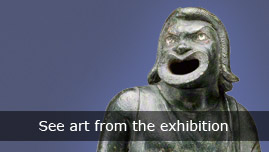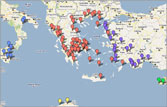| Education | ||
| Exhibitions | ||
| Explore Art | ||
| Research and Conservation | ||
| Bookstore | ||
| Games | ||
| About the J. Paul Getty Museum | ||
| Public Programs | ||
Press Kit |
||
| Museum Home
|
August 26, 2010–January 3, 2011 at the Getty Villa
|
This exhibition explores the many ways Greek drama was interpreted by ancient Greek artists, whose works are frequently the only surviving evidence of the performing arts in antiquity. A wide variety of objects — including sculptures, painted vases, and a rare fragmentary papyrus — brings to life the rich history of ancient Greek theater.
|
|||||||||
|
Colorful characters, elaborate costumes, stage sets, music, and above all masks are hallmarks of ancient drama that are vividly portrayed in the visual arts of Greece. Theater as we know it developed in Athens from choral dances performed as part of the cult of the god Dionysos, inspiring the earliest vase-paintings of performance in the mid-500s B.C. During the following century, the tragedies of Aeschylus, Sophocles, and Euripides as well as the comedies of Aristophanes were presented in competition at the Great Dionysia, an annual celebration of the god's cult in his theater below the Acropolis. There, an audience of thousands together with the actors, chorus, and musicians engaged in a communal marathon of sight and sound. Subsequent generations of Greeks throughout the mainland and colonies of South Italy and Sicily (Magna Graecia) witnessed the restaging of renowned as well as long-lost comedies and tragedies, resulting in a notable artistic output. Theater-related vases from this region are distinguished by innovative imagery that often suggests the painters were present at the performances. In the 300s B.C. the popularity of Menander's comedies spurred the widespread production of statuettes and masks based on character types that remained constant into the Roman period. The exhibition coincides with the Outdoor Theater production of Sophocles' Elektra, with performances from September 9 to October 2, 2010. |
|||||||||
|
||||||||||||||||


